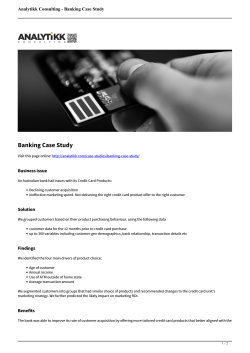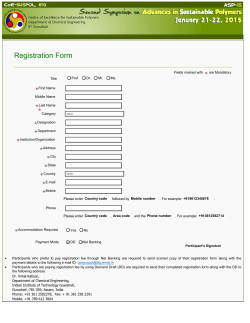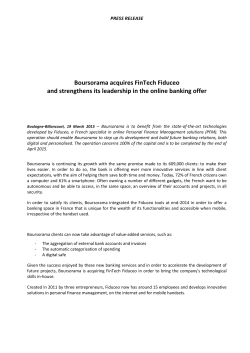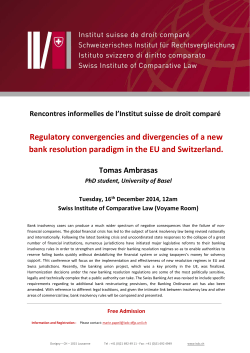
Full Text - PDF - Global Advanced Research Journals
Global Advanced Research Journal of Management and Business Studies (ISSN: 2315-5086) Vol. 4(4) pp. 168-175, April, 2015 Available online http://garj.org/garjmbs/index.htm Copyright © 2015 Global Advanced Research Journals Full Length Research Paper Customer Satisfaction and Trusting in obtaining online banking services Irfan Ullah khan1* Dr.Nadeem Ehsan2, Kashif Ahmad3, Waqas Anwar4 1 Shaheed Zulfiqar Ali Bhutto Institutes of Science and Technology H-8/4, Islamabad, Pakistan. 2 Center for Advanced Studies in Engineering. 19, Ataturk Avenue, Islamabad, Pakistan 3 Shaheed Zulfiqar Ali Bhutto Institutes of Science and Technology H-8/4, Islamabad,Pakistan. 4 University of Engineering, Peshawar. Corresponding author Email: ifraan16@gmail.com Accepted 18 April 2015 In recent years, the banking industry, along with many corporal industries, is undergoing faster transformations. Banks are at the front position in Internet and technology-adoption processes. In today’s world, customers expect superior quality services from banks which if contented, could end up in improved customer satisfaction levels. This quantitative, one-shot research study mainly focuses on investigating the key factors that influence online customers’ satisfaction. Customer satisfaction in case of online banking is seen in terms of bank website quality and the overall bank quality. Bank website quality is judged by variables such as interactivity and customization, perceived security risk and the bank quality is seen by responsiveness and brand image. This study also helps in assessing the rules of these factors in the online banking that would help the bank management not only in improving the satisfaction level and trust but also strengthening the connection between banks and their clients, resulting in expanding their overall customer base. Keywords: Online Banking, Customer Satisfaction, Trust, Interactivity, Customization, Perceived Security Risk, Responsiveness, Brand Image. INTRODUCTION The international scenarios of convergence of the world, from Global Village to the modern day Global Theatre, the technological advancements are the essential factor to connect the world at one-click distance. Every other futuristic development in the world of technology is to speed up the process of ‘communication’. By all means the various industries and organizations communicate with their customers utilizing the fastest means possible on the globe; the competitive advantage of swift contact. This means of communication is established by the revolutionary word, the Internet. Almost every other organization is now completely dependent on it, and is becoming the only means of communication as forecasted by the 2020 Global Vision. In recent years, along with many corporal industries, the banking industry is undergoing faster transformations. Banks are at the front position in Internet and technology-adoption processes. Through this connection, the term Onlinebanking comes forward. Online-banking refers to the automated delivery of banking products/services to khan et al., 169 clients through electronic communication channel Internet. This method is also referred E-banking or PC banking on regular basis as well. Several Pakistani banks look at the innovative ways, such as Online-banking, to make a customer's banking practice more convenient, efficient, and effective. It is becoming even more important to determine the customers’ insight of the overall service quality and their satisfaction in online banking. Measuring customer satisfaction can provide banks useful information about customer loyalty and trust (Ankit, 2011).Website plays a key role in internet banking providing information related to present and potential customers (Jayawardhena & Foley, 2000). It is firmly suggested that the satisfaction level plays a key factor in gaining customer trust in online banking. For this reason, this study aims to provide a justification of the factors that create customer contentment and trust in online banking (Yeh & Li, 2009). LITERATURE REVIEW Information technology has made possible better tracking and accomplishment of commitments, several delivery channels for online customers and quicker resolution of issues (Ankit, 2011). In the present day, customers expect superior quality services from banks which, if fulfilled, could result in better customer satisfaction. The physical partition between bank and customer and customer and monetary consultant and the clear insecurity on internet create challenges to internet banking (Warrington, Abgrab, & Caldwell, 2000). The lack of physical attendance between the bank employees and client in e-banking create a exclusive surroundings in which trust is of main significance. Moreover, it is stated that customer trust as a vital challenge for future in online banking. When service providers have trust from users, users are in general satisfied with their service. Alternatively, with little trust, user’s dont show high satisfaction in the provided service. High satisfaction in ebanking can make repeated use of e-banking services, creating bank profits. On the other hand, low satisfaction levels can even cause banks to lose clients (Aladwani, 2001).Online banking provides the benefit of suitable financial transactions for the clientele. Through internet banking clientele can carry out financial dealings at anytime, anyplace and on the go. Still, this benefit is important only when clients begin to trust e-banking (Chung & Kwon, 2009). The previous research studies have shown that there are several factors influencing the consumer attitude towards online banking – demography, motivation and behavior towards different banking technologies being prime indicators – and every individual’s acceptance for moving towards new technology. It shows that prior experience of computer and new technology can also affect the consumer attitude towards the online-banking (Laforet and Li, 2005). It has also previously recognized ‘Trust’ as a issue in e-banking (Hsu & Lu, 2005). Further studies have examined various topics, like the impact of satisfaction on loyalty (Lin & Wang, 2006). It is previously concluded that the general public hesitate to adopt the online banking options because of the security, trust and privacy factors involved. These are the barriers identified in previous studies against the effective online-banking satisfaction experience. The research focuses on the factors to entertain the research questions and to fulfill the research purposes. Interactivity Interactivity is the amount to which users can take part in modifying the layout and content of a mediated environment in real time (Steuer, 1992) . Definitions of interactivity can be sort out on the basis of the main focus of the authors on features, procedure, insight, or combined approaches (McMillan & Hwang, 2002). Interactivity is termed as the degree to which a person perceives the controls over the interface process, his or her communication equivalent (a person, environment, or a computer-mediated environment) personalizes and responds to his communicative activities (Wu G. M., 2000). Interactivity of the site relates to the optimization of hypermedia characteristics by providing custom-built solutions and enabling bank to give tailored solutions. It is more realistic to provide interactive loan calculations, exchange rate converters, mortgage calculations which can bring benefits to both customers as well as bank in many ways like customers can judge themselves for their loan commitments, these can attract non-customers as well as bank can position itself as central point of electronic commerce (Shariq Shahzad, 2006). The use of technology in business, interactivity influences the customer perception regarding satisfaction. Businesses that add interactivity provides opportunities for growth and market enhancement (Liang & Wei, 2004). According to Mr. Lee (2005) interactivity plays a significant foundation of trust in the online technology. He recommends that the main characteristics of interactivity are everywhere connectivity and the continuation of activities irrespective of time and location (Lee T. M., 2005). Quality factor interactivity is approved as a resource to create satisfaction in transactions; e-business people should provide an interactive setting for customers, particularly first time users (Yeh & Li, 2009). Online banking providers can make the method of using ebanking more reachable by enhancing website interactivity and creating exclusive online experiences (Loonam & Loughlin, 2008). 170 Glo. Adv. Res. J. Manage. Bus. Stud. Interactivity Customization Security Risk Customer’s satisfaction with the bank Customer’s trust in online banking Responsiveness Brand Image Figure 1. Theoretical Framework Customization Customization is a tailoring skill improved by users situation (Lee & Benbasat, 2003). Previous studies define customization as creation of a website more receptive to the exclusive and individual needs of each client (Cingil, Dogac, & Azgin, 2000). Further study explains customization in a website that can mechanically make changes to an entity (Mulvenna, Anand, & Büchner, 2000). Customization is more approachable to customers as well as more modified to person (Mobasher, Cooley, & Srivastava, 2000). Customization in business applications provides opportunities for the development of the business and influence customer satisfaction in online technology. (Liang & Wei, 2004). Customization lessens the information load by sorting out needless information, improving the visual display and providing potential for personalization (Lee & Benbasat, 2003). The researchers suggest that customization can improve the interface and usability which further increase the satisfaction level (Venkatesh, Ramesh, & Massey, 2003). Web site value refers to the satisfaction performance procedure. The significant advantage of online technologies is that website can be modified to the user’s requirements, which is a tough task; due to lack of individual contact (Rust and Kannan, 2002). Online businesses ought to make every effort to tailor services according to individual wishes, that is based on past purchases and information given by clientele (Srinivasan, Anderson, & Ponnavolu, 2002). According to researchers today, a customized website builds more trust, satisfaction, and loyalty. Online customers are more satisfied with websites that are customized to their particular preferences. Localization or customization is the adapting according to desired lookand-feel (Cyr, Kindra, & Dash, 2008). Mr. Simon argues that one single global website not appears practical as various customers are present with different backgrounds; more preferable strategy is to build a website that is consumer specific (Simon, 2001). It is generally received as a fact that in the business, customization is a vital part for workable e-business websites. It is indicated that customization considerably bring higher assurance and tendency to stay with website than those without customization (Fung, 2008). Customization in website is considered important in business and web design fields. Business scholars believe customization as one of the necessary determinants of online business giving a feeling of old rural community, where seller knows clients ,interacts with each and bring changes according to each customer requirements, creating a bond (Lounsbury 2000; Schoder and Madeja 2004). E-commerce practitioners have pushed pitching into customization. For example, now websites welcome users by name, make private recommendations, launch alert e-mail to about their most recent offers etc khan et al., 171 Correlations Interactivity Customization Responsiveness Brand Image Risk Privacy Satisfaction Interactivity Trust 1 Customization .650** 1 Responsiveness .583** .738** 1 Brand Image .285** .360** .587** 1 Risk Privacy .317** .274** .267** .273** 1 Satisfaction .605** .772** .739** .483** .326** 1 Trust .393** .663** .563** .503** .335** .694** 1 **. Correlation is significant at the 0.01 level (2-tailed). Coefficients Standardized Unstandardized Coefficients Model 1 B (Constant) Std. Error Coefficients Collinearity Statistics Beta t Sig. Tolerance .472 .638 VIF .170 .360 -.106 .089 -.114 -1.196 .235 .535 1.869 Customization .686 .125 .624 5.475 .000 .377 2.652 Responsiveness -.037 .112 -.041 -.330 .742 .324 3.084 Brand Image .300 .089 .299 3.372 .001 .623 1.606 Risk Privacy .134 .078 .130 1.717 .089 .860 1.163 Interactivity a. Dependent Variable: Trust (Fung, 2008). E-banks offers personalizes services to construct loyalty as they can mechanically follow with the help of internet individual client services practice and information of their data base (Mols, 2000). Perceived security risk According to (Aldas-Manzano, Ruiz-Mafe, Sanz-Blas, & Lassala-Navarre, 2011)security, privacy is one of the key factor which influence the loyalty in case of online banking and banks needs to keep personal data of customers confidential to reduce the security concerns in the process of transaction. (Rotchanakitumnuai & Speece, 2003) states that Internet-based services have obstacles like issue of trust which is due to the security concerns, system risk and low reliability of transaction. (Ankit, 2011) states that privacy and security apprehension are the major factors that strongly 172 Glo. Adv. Res. J. Manage. Bus. Stud. influence the overall satisfaction level in online banking. Security and Privacy Concern is another factor in online banking. The factor of trust in this case is the security of transaction for consumers and the acceptability rate of the alternative delivery channel that is online (Ankit, 2011). (Rayport & Jaworski, 2004) defines security as the ability of system to avoid illegal or improper use of its information and to discourage cyber-criminals and hackers. Perceived risk in e-banking is defined as the possibility for loss in the search of a desired outcome of using e-banking services. (Jamal & Naser, 2002) suggests that perception of security risk connected with performing financial dealings over the Internet actually creates barrier in the adaptation of Internet banking. Responsiveness Responsiveness refers to rapid response to customer requirements, the pace in solving customer problems, and on time services. Responsiveness level is a necessity for enlargement of loyal customer base as this factor is strongly relates to the overall services quality (Yang, Jun, & Peterson, 2004). Responsiveness is the willingness of service providers to assist customers and provide on time service (Han & Baek, 2004). The main focus in responsiveness is on response pace or time. For users, responsiveness is direct communication as the result of e-mail or inquiry which relates to how speedily marketers react to consumers demand or questions. The quicker the answer, greater is the perception of interactivity. Responsiveness is connected to rightness and correctness of information. Quick response to consumers demand will be considered as timely information to the consumer (Suki, 2011). Responsiveness relates to capability, courtesy, customer service, communication and problem-handling (Wu, Tao, & Yang, 2012). One of the trust’s building sign is responsiveness which can express trustworthiness in online business to customers (Corritore, Beverly, & Wiedenbeck, 2003). Mr. Suki finally concludes that responsiveness does influence the relationship in case of commerce (Suki, 2001). Responsiveness directly leads to satisfaction and this is because customers are more concerned with the honesty of the provider (Lee T. M., 2005). According to Wilson and Gremler, responsiveness has a positive effect on satisfaction but on the other side this may influence negatively if customers feel that they are bombarded with company e-mails and offers (Wilson, Zeithaml, Bitner, & Gremler, 2000). Responsiveness is one of the quality factors in online business which leads to trust building (Lee & Lin, 2005). People place extra faith in a service provider if aid is willingly presented, as a result responsiveness influence trust (Corritore, Beverly, & Wiedenbeck, 2003). The future penetration of e-banking depends on the proactive approach and increasing responsiveness of the website. The access to the financial services is at time not suited to the computerized service providers so the development of website that is highly responsive is important (Loonam & Loughlin, 2008). Brand image Low and Lamb defines brand image as the emotional perception consumers attach to a specific brand (S. Low & W. Lamb Jr, 2000). It is further stated that brand image has positive relation with customer satisfaction and loyalty which strongly influence the consumer attitude towards a product or service (Ogba & Tan, 2009). A strong image leads to better customer satisfaction. Brand image of the service provider do influence customer relationships in case of online business (Suki, 2011). Building brand image require conveying innovation in the brand quality and perception for keep hold of the customers. (S. Low & W. Lamb Jr, 2000) states that consumer focus on that service or product which is branded as compare to unfamiliar product or service. According to (Hinson, Owusu-Frimpong, & Dasah, 2010) building a brand means building total experience. (Martínez & M. Pina, 2003) suggests that brand image connects multi-dimensions as it represents an important outlook and outlook of marketing activities with its variation and connection to conceptualization. Customer satisfaction According to (Pavlou, 2003) customer satisfaction is ancestor of trust. (Singh & Sirdeshmukh, 2000) suggests that the clients post-trust level is affected by the height of pleasure. When a transaction is made customer experience different reactions which affects their level of satisfaction. In case of online services satisfaction, it is the basic performance variable affecting customer perception related to commerce (Yeh & Li, 2009). Online satisfaction can also be defined as the customer contentment with respect to his/ her past purchasing experience in online environment (Anderson & Srinivasan, 2003). Customer satisfaction is extremely known for its vital function in building customer faithfulness (Jamal & Naser, 2002). (Jayawardhena & Foley, 2000) suggests features like download speed, content, plan, interactivity, navigation, security are vital for the development of customer satisfaction in online business. khan et al., 173 It is important for a firm to understand the association among satisfaction and loyalty in the online surroundings to wok accordingly, for example the firm finds that loyalty is linked with enlarged satisfaction; it will work on increasing satisfaction level (Shankar, Smith, & Rangaswamy, 2003). This risk affects the level of trust in online banking. The more experience the person is in using online banking, the more informative they are so risk will be less and trust will be more (Mukherjee & Nath, 2003). THEORETICAL FRAMEWORK Trust Internet creates an extraordinary opportunity for electronic business and trust is measured a key barrier in building customer relations. Construction of trust in ecommerce is hard because of protection fear. Consumers feels self-doubt in doing business dealings without personal dealings (Yeh & Li, 2009). Online trust is defined as the relationship of the individual person with specific transaction or informational website. Trust is considered as a key factor in the success of on-line business. The web designers, developers, consultant marketers all argue that the trust in person–website connections is the most vital factor in the success of the online business (Corritore, Beverly, & Wiedenbeck, 2003). Online and offline trust have few things in common and one of them is the exchange. In both the cases fear, risk associated, complexity and cost limits the exchange to take place but the corporation, coordination and harmonization enhances the exchange to take place. The interaction rule in both the surroundings remains the same. The offline trust research relates to the online trust as in both the environment the absence of trust create risk, fear and complexity. In offline environment trust is asset that creates coordination and cooperation; same is the case in the online environment. Here website represents internet technology for business, the interaction between person and site or the backend people behind the website. In online business website acts as sales person as well as storefront (Corritore, Beverly, & Wiedenbeck, 2003). Trust is considered as one of the most important factor in online banking from consumer’s point of view (Benamati & Serva, 2007). (Chae & Kim, 2003) suggests that faith is the main aspect for accomplishment in eenvironment. Trust in online banking relates to the security in transaction from the customers and the acceptance of alternative channel that is online (Rayport & Jaworski, 2004). In case of online banking the customer trust is dynamic rather than stationary, it changes from instance to instance because there is no face to face interaction, so building trust is difficult but once the trust is built it continue (Chung & Kwon, 2009). The problem of trust exits because financial dealings involves threat which stands true in case of e-banking, where bank and client are actually separated, relationship is hard to build plus cyber laws are not clearly defined. Interactivity: The degree to which a person perceives the controls over the interface process (Wu G. M., 2000). Customization: Making a website 11more responsive to the unique and individual needs of each user (Cingil, Dogac, & Azgin, 2000). Responsiveness: Willingness of service providers to assist customers and provide on time service (Han & Baek, 2004). Brand Image: The emotional perception consumers attach to a specific brand (S. Low & W. Lamb Jr, 2000). Security Risk: The ability of system to avoid illegal or improper use of its information and to discourage cybercriminals and hackers (Rayport & Jaworski, 2004). Customer Satisfaction: Customer contentment with respect to his/ her past purchasing experience in online environment (Anderson & Srinivasan, 2003). Trust: Relationship of the individual person with specific transaction or informational website (Corritore, Beverly, & Wiedenbeck, 2003). METHODOLOGY Sample selection A sample size of 100 will be exercised, which will include male and female population from Islamabad and Rawalpindi. To obtain accurate and clear-cut information, the population area for our research will be limited to the institutions present in Islamabad and Rawalpindi only. This will be a basic, quantitative research based on calculations by evaluating the public perspective. The research will be conducted through Surveys. Questionnaire will be employed to gather the required information from all variables handled. CONCLUSION This research examines the factors that influence customer satisfaction and trust in online banking. The study shows that that satisfaction in online banking is not significantly influenced by interactivity where as satisfaction in online banking is influenced by factors such as customization, responsiveness, brand image and risk privacy. The findings also shows that users’ trust in online banking is affected by their satisfaction level. Align with past studies, satisfaction is an important determinant of customer trust (Chae, Kim, Kim and Ryu, 2002; Li and 174 Glo. Adv. Res. J. Manage. Bus. Stud. Yeh, 2009; Yeh and Li, 2009). FUTURE RESEARCH/SCOPE/ LIMITATIONS OF THE STUDY IMPLICATION AND As we had shortage of time so we covered only a small geographical area. Moreover sample size was not too much large due to cost issue. It is documented that this convenience sample, in its demographic limitations, would place limitations on the overview of the results of this study to other geographic regions or to the general population. Another main inadequacy of the study is the impending for widespread source biases (Podsakoff, 2003), which explains that normally one questionnaire is used for the study. We just studied the effect of five variables on the dependent variable. Furthermore the moderating affect of different variables could also impart in the future researches. This study is conducted in the Pakistani market context further more this study was conducted in banking sector. Future research can be conducted by other sampling technique like probability sampling technique such as stratified. The bigger the geographic region included in this type of research, the more representative the result will be. Future research may be conducted in the other sector like hotels and other services sectors. Scope of this study is limited because the result may differ in other cultures because of this the study could not implement in other areas. REFERENCES Aladwani AM (2001). Online Banking: a field study of divers, development challenges, and expectation. International Journal of Information Management , 21, 213-215. Aldas-Manzano J, Ruiz-Mafe C, Sanz-Blas S (2012). Internet banking loyalty: evaluating the role of trust, satisfaction, preceived risk and frequency of use. The Service Industry Journal , 31 (7), 1165-1190. Anderson RE, Srinivasan SS, (2003). E-satisfaction and e-loyalty: A contingency framework. Psychology and Marketing , 20 (2), 123-138. Ankit S (2011). Factors Influencing Online Banking Customer Satisfaction and Their Importance in Improving Overall Retention Levels: An Indian Banking Perspective. Information and Knowledge Management , 1 (1), 45-54. Benamati J, Serva M (2007). Innovation chararcteristics and innovation adoption implementation. IEEE Transaction of Engineening Management , 9, 34-35. Chae M, Kim J (2003). What's so different about the mobile Internet? Communications of the ACM , 46 (12), 240-247. Chung N, Kwon SJ (2009). Effect of trust level on mobile banking satisfaction:a multi-group analysis of information system success instruments. Taylor and Francis , 28 (6), 549-562. Cingil I, Dogac A, and Azgin A, (2000). A broader approach to personalization. Communication of the ACM , 43 (8), 136-141. Corritore CL, BK, Wiedenbeck S (2003). On-line trust: concepts, evolving themes, a model. International Journal of Human-Computer Studies , 58 (6), 732-758. Cyr D, Kindra GS, Dash S (2008). Website design, trust, satisfaction and e-loyalty:The Indian experience. Online Information Review , 32 (6), 773-790. Fung TK (2008). Banking with Personalized Touch. Journal of Electronic Commerce Research , 9 (4), 296-309. Han SL, and Baek S,(2004). Antecedents and consequences of service quality in online banking: an application of the SERVQUAL instrument. Advances in Consumer Research , 31, 208-214. Hinson R, Owusu-Frimpong N, and Dasah J, (2010). Brands and service-quality. Marketing Intelligence and Planning , 29 (3), 264-283. Hsu, CL, and Lu, HP. (2005). Consumerbehavior in online game communities: A motivational factor perspective. Computers in Human Behavior , 23 (3), 1642-1659. Jamal A, and Naser K. (2002). Customer satisfaction and retail banking: an assessment of some of the key antecedents of customer satisfaction in retail banking. International Journal of Bank Marketing , 20 (4), 146-160. Jayawardhena C, and Foley P. (2000). Changes in the banking sector – the case of Internet banking in the UK. Internet Research , 10 (1), 1931. Lee GG, and Lin HF, (2005). Customer perceptions of e-service quality in online shopping. International Journal of Retail and Distribution Management , 33 (2), 161-176. Lee TM. (2005). The impact of perceptions of interactivity on customer trust and transaction intentions in mobile commerce. Journal of Electronic Commerce Research , 6 (3), 165-180. Lee YE, and Benbasat I. (2003). Interface design for mobile commerce. Communication of the ACM , 46 (12), 49-52. Liang TP, and Wei CP. (2004). Introduction to the special issue: Mobile Commerce Applications. International Journal of Electronic Commerce , 8 (3), 7-17. Lin HH, and Wang YS. (2006). An examination of the determinants of customer loyalty in mobile commerce contexts. Information and Management , 43 (3), 271-282. Loonam M, and Loughlin D. (2008). An observation analysis of eservice quality in online banking. Journal of Financial Services Marketing , 13, 164-178. Martínez E, and M Pina J. (2003). The negative impact of brand extensions on parent brand image. Journal of Product and Brand Management , 12 (7), 432-448. McMillan SJ, Hwang JS (2002). Measures of perceived interactivity:an exploration of the direction of communication,user control and time in shaping perception of interactivity. Journal of Advertising , 31 (3), 2942. Mobasher B, Cooley R, Srivastava J (2000). Automatic personalization based on the web usage minning. Communication at the AMC , 43 (8), 142-151. Mols NP (2000). The Internet and services marketing – the case of Danish retail banking. Internet Research , 10 (1), 7-18. Mukherjee A, Nath P (2003). A model of trust in online relationship banking. International Journal of Bank Marketing , 21 (1), 5-15. Mulvenna MD, Anand SS, Büchner AG (2000). Personalization on the net using web mining. Communications of the AMC , 43 (8), 123-126. Ogba IE, Tan Z (2009). Exploring the impact of brand image on customer loyalty and commitment in china. Journal of Technology Management , 4 (2), 132-144. Pavlou PA (2003). Consumer acceptance of electronic commerce: integrating trust and risk with the technology acceptance model. International Journal of Electronic Commerce , 7 (3), 101-137. Rayport JF, Jaworski BJ (2004). E-commerce:security issues. International Journal of Online Security , 42 (1), 41-57. Rotchanakitumnuai S, and Speece M (2003). Barriers to Internet banking adoption: a qualitative study among corporate customers in Thailand. International Journal of Bank Marketing , 21 (6), 312-323. S LowG, WLamb Jr C (2000). The measurement and dimensionality of brand associations. Journal of Product and Brand Management , 9 (6), 350-370. Shankar V, Smith AK, and Rangaswamy A. (2003). Customer Satisfaction and Loyalty in Online and Offline Environments. Research in Marketing , 20, 153-175. Simon SJ (2001). The impact of culture and genderon web sites:an empirical study. The Data Base for Advances in Information Systems , 32 (1), 18-37. Singh J, Sirdeshmukh D (2000). Agency and Trust Mechanisms in Consumer Satisfaction and Loyalty Judgments. Journal of the Academy of Marketing Science. , 28 (1), 150-167. khan et al., 175 Srinivasan SS, Anderson R, Ponnavolu K (2002). Customer loyalty in e-commerce: an exploration of its antecedents. Journal of Retailing , 78, 41-50. Steuer J (1992). Defining virtual reality:dimensions determining telepresence. Journal of Communication , 42 (4), 79-93. Suki NM (2011). A structural model of customer satisfaction and trust in vendors. Int. Journal of Business Science and Applied Management , 6 (2), 17-31. Venkatesh V, Ramesh V, Massey AP (2003). Understanding usability in mobile commerce. Comminication of the ACM , 46 (12), 53-56. Warrington TB, Abgrab Nj, Caldwell HM. (2000). Building trust to develop competitive advantage in e-business relationships. Competitiveness Review: An International Business Journal incorporating Journal of Global Competitiveness , 10 (2), 160-168. Wilson A, Zeithaml V, Bitner MJ, Gremler D (2000). Services marketing: integrating customer focus across the firm. (2, Ed.) New York: McGraw-Hill. Wu GM (2000). The role of perceived interactivity in interactive ad processing. The University of Texas at Austin: Doctoral Dissertation. Wu YL, Tao YH, Yang PC (2012). Learning from the past and present:measuring Internet banking service quality. The Service Industries Journal , 32 (3), 477-497. Yang Z, Jun M, Peterson RT (2004). Measuring customer perceived online service quality. International Journal of Operations and Production Management , 24 (11), 1149-1174. Yeh YS, Li YM (2009). Building trust in m-commerce: contributions from quality and satisfaction. Online Information Review , 33 (6), 1066-1086.
© Copyright 2025









